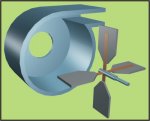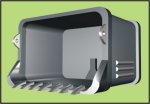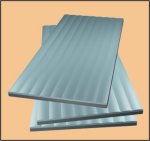 |
 |
 |
 |
 |
 |
Hard Metal Linings
Mike Hall
Acknowledgements : Bionic Research Institute - Chute Design Conference 1992
A WIDE variety of hard metal linings are available to resist wear and abrasion in chutes.
This paper examines hard lining materials, and provides guidelines for their selection and use.
Mike Hall is Technical Manager for VRN Steel. He has a Higher National Diploma in Welding Technology from the Witwatersrand Technikon.
HANDLING ABRASIVE PRODUCTS
INTRODUCTION
In many materials handling environments and especially in the mining and earthmoving industry, high hardness wrought steel plates are being used more extensively in order to combat wear and abrasion. Similarly, high strength low alloy structural steels are being used more frequently in structures in order to gain mass saving advantages and increased payload capacities.
Most wear plate applications involving mining, excavating, loading, hauling, conveying under severe impact and gouging abrasion conditions. In this aggressive type of service liners and wear plates require a combination of properties including high strength, abrasion resistance, toughness, weld ability and relative ease of fabrication. Locally available grades of high hardness steels have been shown to satisfy these requirements in terms of cost effectiveness, availability, performance and engineering properties.
ABRASION RESISTANT GRADES
Abrasion resistant grades of steel are characterised by an almost universal absence of standards covering their manufacture - they are virtually always marketed under proprietary trade names and their supply is controlled by steel manufacturer's specifications and particular customer requirements. The chemical compositions of some abrasion resisting grades are specified by reference to an existing steel specification (e.g. ASTM 514 Grade J), but the mechanical properties of that specification are waived and replaced by a hardness specification only e.g. 360, 400 or 500 brinell.
The one unifying factor among the many proprietary specifications for abrasion resistant Q & T steel, is the reliance on surface hardness, as measured by the Brinell hardness test method.
In selecting the correct hardness of abrasion resisting plate, consideration should be given to the required fabrication operations, particularly if forming is required. Table 1 lists typical compositions and hardness of some abrasion resisting grades.
CHEMICAL COMPOSITION (%,MAX)
|
GRADE |
C |
Si |
Mn |
P |
S |
Cr |
Mo |
V |
Ti |
B |
HARDNESS |
|
ROQ LAST AD 360 |
0,21 |
0,35 |
0,7 |
0,035 |
0,04 |
- |
0,65 |
- |
- |
0,005 |
360 min |
|
X.A.R. 30-400 |
0,3 max |
0,7 |
1,0 |
0,025 |
0,025 |
0,8 |
0,1 |
- |
- |
- |
400 min |
|
VRN 500 |
0,35 max |
0,55 |
1,6 |
0,03 |
0,03 |
1,2 |
0,5 |
0,1 |
0,02 |
0,02 |
500 |
Table 1: Chemical composition and hardness of typical abrasion resistant grades
HIGH STRENGTH STRUCTURAL GRADES
A number of international standards exist which cover the manufacture and supply of a range of high strength Q & T structural grades e.g. ASTM A5141A517, A533, A678,ISO 4950/3 grades E420 -E690, BS 4360 Grade 55F. Internationally, the ASTM A514 I A517 specifications are generally adhered to with particular steel producers aligning their proprietary grades to one or more of the fifteen grades in these specifications. In fact, the mechanical properties specified in ASTM A 514 I A 517 tend to form the basis of [ all of the commercially important, proprietary steels with a specified minimum yield strength of 690 MPa eg. TI, Roq Tuf and VRN T 690. Table 2 lists typical chemical compositions.
CHEMICAL COMPOSITION (%,MAX)
|
GRADE |
C |
Si |
Mn |
P |
S |
Cr |
Mo |
Ni |
B |
|
ASTM A514 GRADEJ |
0,21 |
0,35 |
0,7 |
0,035 |
0,04 |
- |
0,65 |
- |
0,005 |
|
ASTM A514 GRADE M |
0,21 |
0,35 |
0,7 |
0,035 |
0,04 |
- |
0,60 |
1,5 |
0,005 |
|
ASTM A514 GRADE P |
0,21 |
0,35 |
0,7 |
0,035 |
0,04 |
1,20 |
0,60 |
1,5 |
0,005 |
Table 2: Chemical composition of structural grades. All grades must meet a minimum yield strength of 690 Mpa
This paper attempts to give a better understanding of some of the more popular wear and abrasion resisting flat products which are readily available in South Africa.
HIGH CARBON STEELS
These steels generally have a carbon content of between 0,4 -0,55 % C and a hardness in the region of 200 BHN. They are produced as as-rolled steels i.e. hot rolled and allowed to air cool.
Higher cooling rates would result in harder plate with increased brittleness with the accompanying increase in susceptibility to cracking in even moderate impact applications. The high carbon content can also lead to cracking problems associated with welding if high preheats and basic hydrogen controlled electrodes are not used. Alternatively, the higher alloyed austenitic consumables may be used e.g. E309, E310, E312 (with the associated increase in cost) The preferred method of attachment is by drilling and bolting. Although this is a relatively low cost material to use as liners, the frequency of replacement of the liners should be taken into account when considering cost effectiveness. The closest standard specification would be A.I.S.I/SAE 1045 or 1050.
QUENCHED & TEMPERED STEELS
These are by far the most popular steels used for abrasion and wear resistance and range in hardness from 280 - 525 BHN. The hardness depends on thickness with the thinner plates being harder. A better understanding of these steels is possible is one if aware of the manufacturing process.
MANUFACTURE OF Q & T STEELS
After making the necessary alloy additions to the ladle, casting and rolling on a plate mill in the conventional manner, modern Q & T plate grades are then subjected to a heat treatment cycle as follows:-
- The plates are heated to the austenitising temperature (900 -950 Degree C) and soaked at that temperature for a period determined by plate thickness and chemical composition.
- From the heating furnace, the plates are moved on rollers to a roller pressure quench unit where they are quenched with water by being sprayed simultaneously on both surfaces. Roller pressure quenching prevents the plate from buckling and also ensures consistent mechanical properties across the plate. The as - quenched condition represents maximum strength and hardness coupled with relatively low ductility.
- After hardening by quenching, the plates are reheated in a tempering furnace to a temperature dependent on the desired combination of properties. The period of time is related to thickness and chemical composition.
High strength structural grades of Q & T steels have typical tempering temperatures of 550- 650 degrees C, while abrasion resisting grades in which surface and through thickness hardness are the main criteria, are tempered in the range of 200- 550 degrees C.
Understanding the thermal history of heat treated steels enables engineers to make sound decisions when selecting steels and subsequent manufacturing processes such as forming, cutting and welding.
FABRICATION
CUTTING
High strength structural grades and abrasion resistant grades of Q & T steels may be readily cut using the same conventional equipment used for cutting normal mild steel.
Oxy/acetylene and oxy/LPG mixtures are suitable as well as plasma cutting, provided that the equipment is able to cut the required thickness.
When stripping plates, the use of parallel torches will help to minimise distortion. Under normal cutting conditions the total heat affected zone will extend into the plate only about 2 mm.
If the flame cut face is to be the surface of a welded joint, the heat affected zone from cutting need not be removed. All loose scale and slag should be removed by light grinding, and prior to welding the cut surface should be dry and free from organic materials such as oil, grease, paint etc.
Q & T steels should not be stack cut as excessive heat input may result in over-tempering and loss of hardness and strength.
FORMING
Considerably more power is required for forming the Q & T steels compared to mild steel and allowance must also be made for greater springback.
The suggested minimum inside radius when forming the structural grades is 3 x plate thickness and 15 x plate thickness for the abrasion resisting grades. It should always be attempted to position the bend axis transverse to the plate rolling direction.
In very cold conditions it is advisable to warm the plate slightly (30 degrees C) prior to forming.
WELDING
Both the high strength structural grades and the abrasion resistant grades are readily wieldable by all the conventional arc welding processes such as shielded metal arc welding (SMAW), flux cored arc welding (FCAW), gas metal arc welding (GMAW) and submerged arc welding (SAW).
Because Q & T steels differ from conventional steels, welding procedures and practices, while relatively simple and straightforward, are also different. In particular it is necessary to observe limitations on both maximum and minimum total weld heat input.
When welding any of the abrasion resistant grades it is suggested that lower strength consumables be used such as those conforming to AWS A 5.1, E7O15, E7O16 or E7O18 for shielded metal arc welding or wire to AWS A5,18 ER 7OS - 6 for gas shielded arc welding. Suitable electrodes are listed in table 3.
|
SUPPLIER |
S.M.A.W. (MMA) |
G.M.A.W. (MIG-CO2) |
|
Afrox |
Transarc 7018 - 1 |
Transarc 6000 |
|
Arc Engineering |
Speedarc |
MIGARC |
|
Bohler |
Fox EV 50 |
|
|
Fedgas |
Fedcorona |
FE 65 |
|
Oerlikon |
Tenacito 38 R |
Gold Dot |
|
UTP |
UTP 613 Kb |
|
|
Brandweld |
BW 008 |
BW 570 |
Table 3: Suitable locally available consumables which may be used for welding the abrasion resisting grades of quenched and tempered steels.
Suggested minimum and maximum heat inputs and preheats.
|
Combined thickness |
Minimum preheat
temperature |
Minimum heat input |
Maximum heat input |
|
6 mm |
20 |
0.6 |
1.4 |
|
12 mm |
50 |
1.1 |
1.9 |
|
25 mm |
90 |
2.1 |
2.3 |
|
32 mm |
120 |
2.3 |
2.8 |
|
100 mm |
150 |
2.3 |
3.2 |
Table 4: Heat input schedule for all grades of wear resistant grades of quenched and tempered steel.
When welding the structural grades to themselves, matching strength or slightly lower strength consumables are usually suggested. Suitable consumables should conform to AWS A5.5. E9O18, ElOO18 or EllO18 for SMAW or AWS A5.28, ER9OS or ERlOOS for GMAW.
Suggested preheats for the structural grades.
|
PLATE |
COMBINED |
MINIMUM PRE-HEAT |
MAXIMUM HEAT INPUT
VALUES |
|
10 |
20 |
35 |
1.0-1.5 |
|
30 |
35 |
1.0-1.5 |
|
|
40 |
35 |
1.0-1.5 |
|
|
20 |
40 |
50 |
1.5-2.0 |
|
60 |
50 |
1.5-2.5 |
|
|
80 |
80 |
1.5-3.0 |
|
|
30 |
60 |
50 |
2.0-3.0 |
|
90 |
80 |
2.5-3.5 |
|
|
120 |
100 |
2.5-4.0 |
|
|
50 |
100 |
80 |
2.5-4.0 |
|
150 |
100 |
2.5-4.0 |
|
|
200 |
125 |
2.5-4.0 |
Table 5: Heat input schedule for all grades of high strength quenched and tempered steel.
Note it is important to carry out procedure tests in order to establish exact welding parametersAlthough steel mills produce wear resistant grades of plate with chemical compositions according to A.S.T.M. A514/517, these grades are generally available with a hardness of 360 BHN (min}. Plates with hardness of 400 BHN (min) and 500 BHN (nominal} are usually produced to individual mills internal specifications. Welding procedures employed on steels up to 360 BHN can in general be used for the harder grades. However, forming and machining characteristics of the harder grades differ significantly and reference should be made to the supplier.
The higher hardness grades in thickness up to 38,0mm find extensive use in applications such as chute liners, grizzly's, L.H.D. bucket lips, dragline bucket liners and dump truck bowl liners.
WELDED OVERLAY PLATE
The weld deposit has a very high hardness (typically 600 BHN} and is most suitable in applications involving severe abrasion and light or moderate impact. The plates consist of an iron - chromium - carbide alloy which has been fused onto a mild steel backing plate. The ultra-hard chromium carbide particles are suspended in a hard, tough matrix, a combination which offers optimum abrasion resistance.
The mild steel backing material allows the overlay plate to be rolled, bent, formed and fabricated into a multitude of abrasion-resistant applications. During the overlay process the stresses present due to expansion and contraction are relieved by cracking of the hard surface deposit. Crack frequencies of more than one crack per 25mm are desirable and indicate that there is no simultaneous cracking away of the hard layer from the mild steel base.
Because of the ductile backing plate, forming is relatively simple. The plates can only be plasma cut.
Figures above show typical applications.
STAINLESS STEELS
Various grades of austenitic, ferritic and martensitic stainless steels are used in materials handling applications where both corrosion and abrasion are involved. They do however tend to be used where corrosion is more of a problem and the slideablilty needs to be maintained. 3CR12 has found extensive use in the coal mining and power generation industry. Under conditions of dry abrasion and high impact, it is suggested that 3CR12 not be used and a more cost effective alternative be considered. Development work is currently being carried out on high hardness (440BHN) martensitic grades of stainless steel and so far the results appear very encouraging.
CONCLUSION
Materials used to combat wear will eventually need to be replaced after a certain period in service. The choice as to what material to use rests with the engineer who has to consider cost effectiveness and east of replacement and if he is aware of the various materials available, the decision is usually easier.
REFERENCES1. AWRA technical note 15.
2. Bisalloy technical manual.
